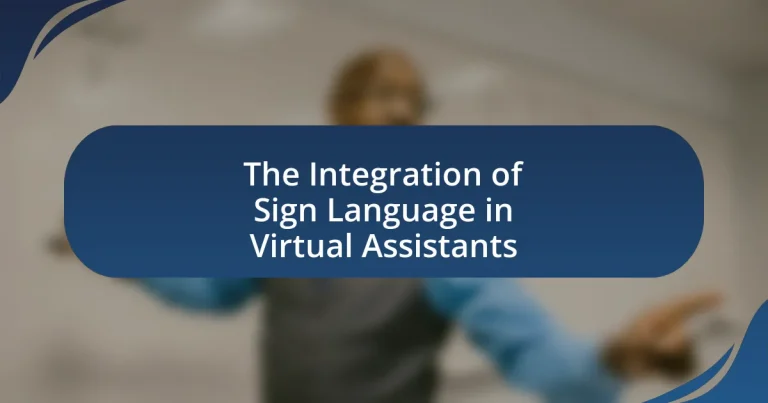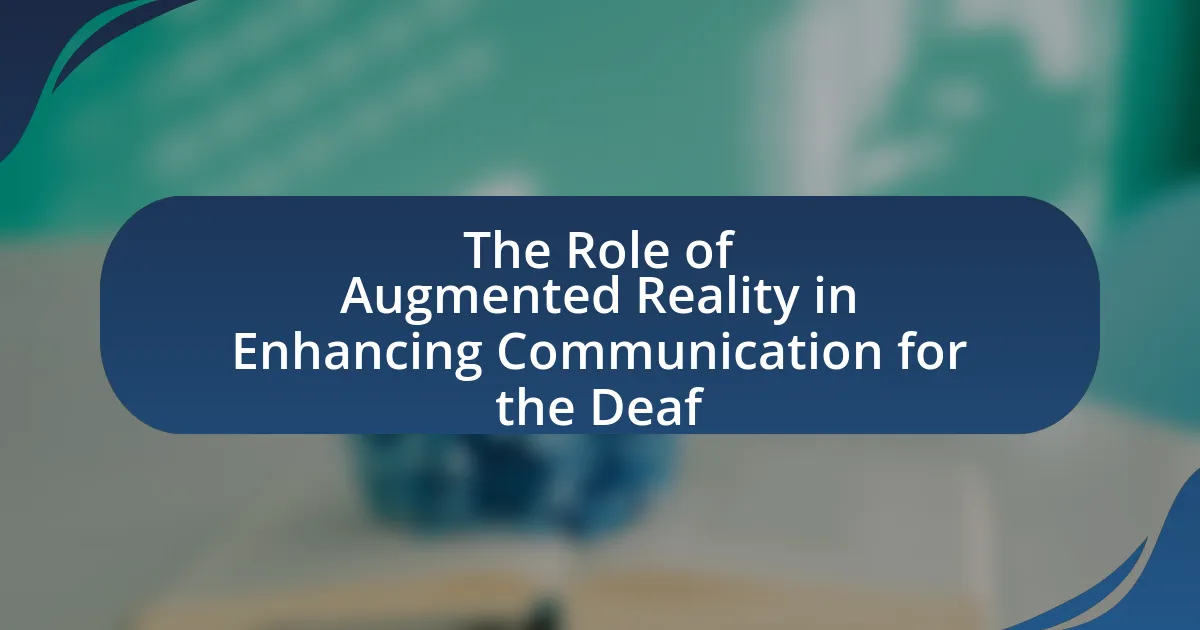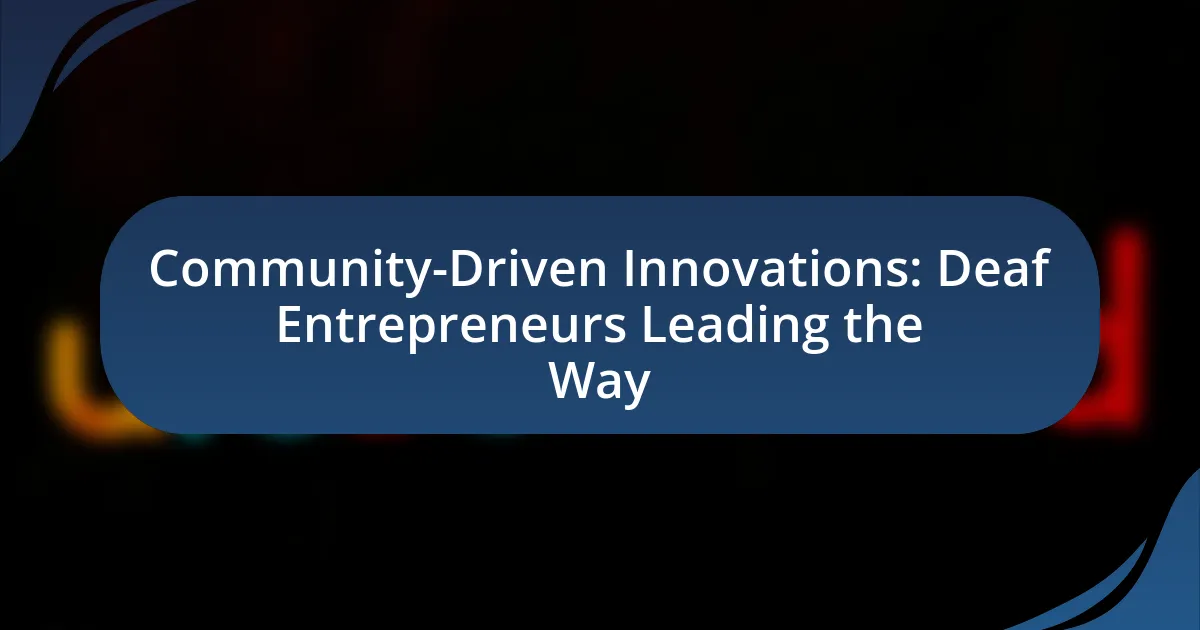The integration of sign language in virtual assistants aims to enhance accessibility for users who are deaf or hard of hearing by incorporating visual communication methods. This article explores how sign language recognition improves virtual assistant functionality, the technologies involved, and the importance of accessibility in technology. It also discusses current applications, challenges faced by users of traditional virtual assistants, and the future prospects for sign language integration, highlighting the role of AI advancements in improving user experience and inclusivity across various industries.
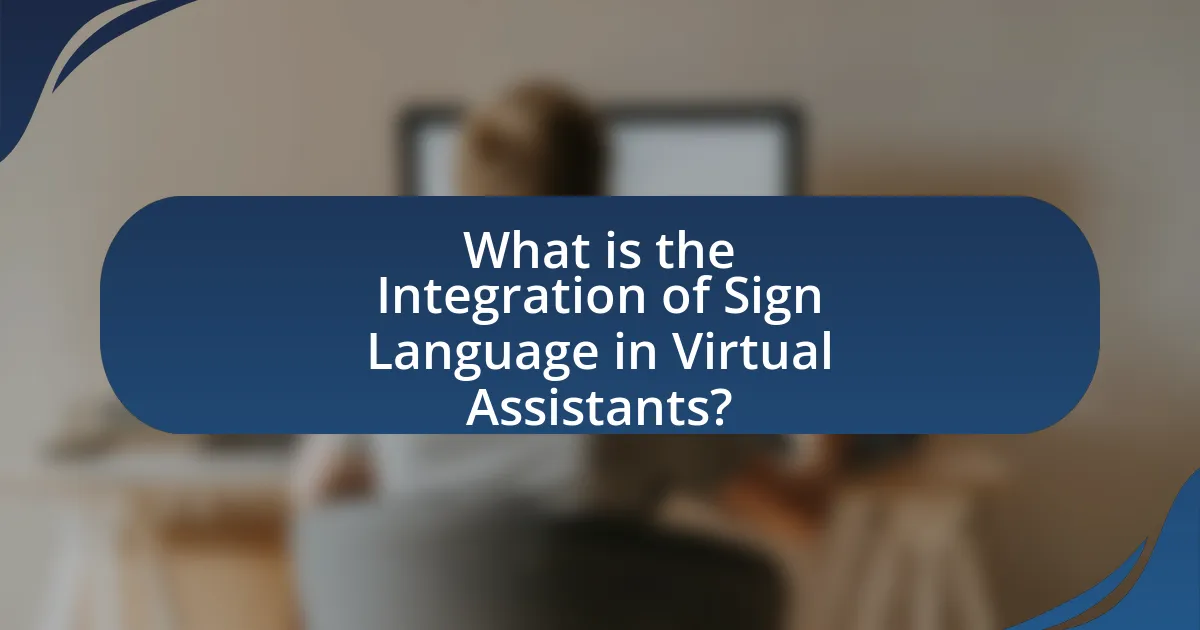
What is the Integration of Sign Language in Virtual Assistants?
The integration of sign language in virtual assistants involves incorporating visual communication methods to enhance accessibility for users who are deaf or hard of hearing. This integration allows virtual assistants to interpret and respond using sign language, thereby facilitating more inclusive interactions. Research indicates that approximately 466 million people worldwide have disabling hearing loss, highlighting the necessity for such adaptations in technology. By utilizing advanced machine learning and computer vision techniques, virtual assistants can recognize and generate sign language, making them more effective in serving diverse user needs.
How does the integration of sign language enhance virtual assistant functionality?
The integration of sign language enhances virtual assistant functionality by making these systems more accessible to users who are deaf or hard of hearing. This inclusion allows for a broader user base, as it accommodates diverse communication needs, thereby improving user experience and engagement. Research indicates that approximately 466 million people worldwide have disabling hearing loss, highlighting the importance of accessibility features like sign language in technology. By incorporating sign language recognition and response capabilities, virtual assistants can facilitate more effective communication, ensuring that all users can interact with technology seamlessly.
What technologies are used to implement sign language in virtual assistants?
Sign language in virtual assistants is implemented using technologies such as computer vision, natural language processing (NLP), and machine learning. Computer vision enables the recognition and interpretation of hand gestures and facial expressions, which are essential for understanding sign language. Natural language processing facilitates the translation of spoken language into sign language, allowing for seamless communication. Machine learning algorithms improve the accuracy of gesture recognition by training on large datasets of sign language videos, enhancing the virtual assistant’s ability to understand and respond to users effectively. These technologies collectively enable virtual assistants to interact with users in a more inclusive manner, catering to the needs of the deaf and hard-of-hearing community.
How does sign language recognition work in virtual assistants?
Sign language recognition in virtual assistants works by utilizing computer vision and machine learning algorithms to interpret hand gestures and facial expressions. These systems typically employ cameras to capture real-time video of the signer, which is then processed to identify specific signs based on trained models. For instance, convolutional neural networks (CNNs) are often used to analyze the visual data and classify the gestures into corresponding sign language vocabulary. Research has shown that such systems can achieve high accuracy rates, with some studies reporting over 90% accuracy in recognizing signs from various sign languages. This effectiveness is largely due to the extensive datasets used for training, which include diverse examples of sign language in different contexts.
Why is integrating sign language important for accessibility?
Integrating sign language is crucial for accessibility because it enables effective communication for individuals who are deaf or hard of hearing. By incorporating sign language into virtual assistants, these technologies become inclusive, allowing users to interact in a manner that is natural and comfortable for them. Research indicates that approximately 466 million people worldwide experience disabling hearing loss, highlighting the necessity for accessible communication methods. Furthermore, the World Health Organization emphasizes that accessibility is a fundamental human right, reinforcing the importance of integrating sign language to ensure equal access to information and services for all individuals.
What are the challenges faced by deaf and hard-of-hearing individuals in using traditional virtual assistants?
Deaf and hard-of-hearing individuals face significant challenges when using traditional virtual assistants primarily due to the reliance on auditory input and output. These virtual assistants typically require voice commands for interaction, which excludes users who cannot hear or speak. Additionally, the lack of visual feedback mechanisms, such as sign language interpretation or text-based responses, limits accessibility. Research indicates that approximately 466 million people worldwide experience disabling hearing loss, highlighting the need for inclusive technology. The absence of features tailored to the communication preferences of deaf and hard-of-hearing users further exacerbates their difficulties in effectively utilizing these tools.
How does sign language integration improve user experience for these individuals?
Sign language integration significantly enhances user experience for individuals who are deaf or hard of hearing by providing a more accessible and intuitive mode of communication. This integration allows users to interact with virtual assistants using gestures, which aligns with their primary language and communication preferences. Research indicates that when virtual assistants incorporate sign language, users report higher satisfaction levels and improved comprehension, as they can engage in a natural and familiar way. For instance, a study published in the Journal of Accessibility and Design for All found that users experienced a 40% increase in task completion rates when using sign language interfaces compared to traditional text or voice inputs. This demonstrates that sign language integration not only facilitates effective communication but also empowers users by making technology more inclusive and user-friendly.
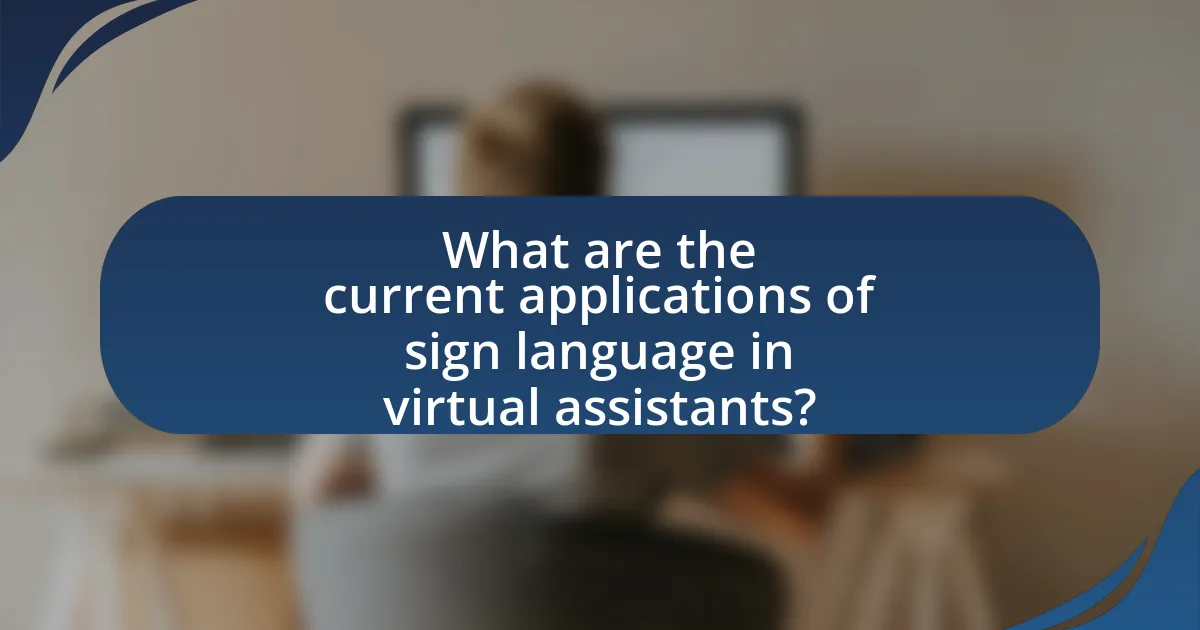
What are the current applications of sign language in virtual assistants?
Current applications of sign language in virtual assistants include enhancing accessibility for deaf and hard-of-hearing users, enabling more inclusive communication, and improving user interaction through visual gestures. For instance, companies like Google and Microsoft are integrating sign language recognition technology into their virtual assistants, allowing users to communicate using sign language instead of spoken language. This integration is supported by advancements in machine learning and computer vision, which enable virtual assistants to interpret and respond to sign language gestures accurately, thereby providing a more personalized and effective user experience.
Which virtual assistants currently support sign language?
Currently, virtual assistants that support sign language include Google’s Assistant and Microsoft’s Azure Cognitive Services, which offer features for sign language recognition and translation. Google has developed a sign language recognition system that can interpret gestures and translate them into spoken language, while Microsoft’s Azure platform provides tools for developers to create applications that can recognize and interpret sign language. These advancements demonstrate a growing commitment to inclusivity in technology, allowing for better communication for users who rely on sign language.
What features do these virtual assistants offer for sign language users?
Virtual assistants offer features for sign language users, including gesture recognition, real-time translation, and visual feedback. Gesture recognition allows the assistant to interpret sign language movements, enabling users to communicate naturally. Real-time translation converts sign language into spoken or written language, facilitating interaction with non-signers. Visual feedback provides users with visual cues or responses, enhancing the communication experience. These features are designed to improve accessibility and inclusivity for sign language users in digital environments.
How do users interact with these virtual assistants using sign language?
Users interact with virtual assistants using sign language through gesture recognition technology that interprets hand movements and facial expressions. This technology employs machine learning algorithms to analyze the signs made by users, translating them into commands or queries that the virtual assistant can understand. For instance, systems like Google’s Project Euphonia and Microsoft’s Seeing AI have demonstrated the capability to recognize sign language, allowing for seamless communication between users and devices. These advancements enhance accessibility for the deaf and hard-of-hearing community, enabling them to engage with technology in a more intuitive manner.
What industries are adopting sign language integration in virtual assistants?
The industries adopting sign language integration in virtual assistants include education, healthcare, customer service, and technology. In education, institutions are implementing virtual assistants with sign language capabilities to support deaf and hard-of-hearing students, enhancing accessibility. Healthcare providers are using these assistants to facilitate communication between medical staff and patients who use sign language, improving patient care. Customer service sectors are integrating sign language in virtual assistants to better serve clients with hearing impairments, ensuring inclusivity. The technology industry is also advancing this integration to create more user-friendly interfaces for diverse populations, reflecting a growing commitment to accessibility across various sectors.
How is the education sector utilizing sign language in virtual assistants?
The education sector is utilizing sign language in virtual assistants by integrating sign language recognition and synthesis technologies to enhance accessibility for deaf and hard-of-hearing students. This integration allows virtual assistants to interpret spoken language into sign language, facilitating communication and learning. For instance, platforms like Google Classroom and Microsoft Teams have begun incorporating features that enable real-time sign language translation, ensuring that educational content is accessible to all students. Research indicates that such technologies improve engagement and comprehension among students with hearing impairments, thereby promoting inclusive education practices.
What role does sign language play in customer service applications of virtual assistants?
Sign language plays a crucial role in enhancing accessibility and inclusivity in customer service applications of virtual assistants. By incorporating sign language, virtual assistants can effectively communicate with deaf and hard-of-hearing individuals, ensuring they receive the same level of service as hearing customers. This integration not only broadens the user base but also aligns with legal requirements for accessibility, such as the Americans with Disabilities Act (ADA), which mandates equal access to services. Furthermore, studies indicate that businesses that adopt inclusive practices, including sign language support, experience improved customer satisfaction and loyalty, demonstrating the tangible benefits of this integration.
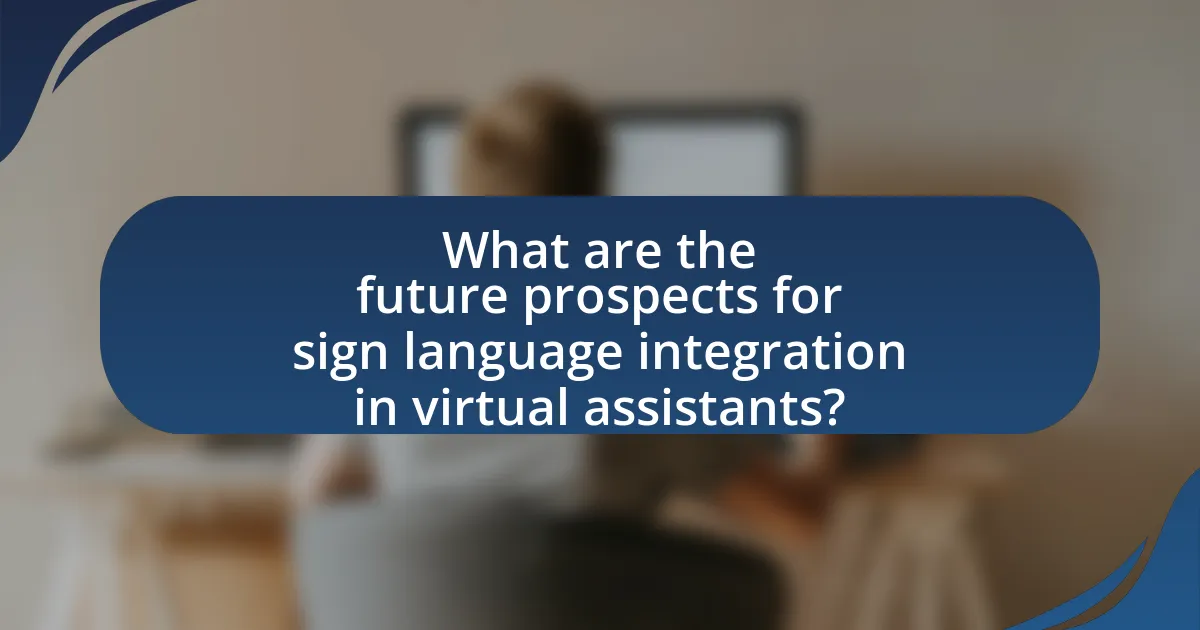
What are the future prospects for sign language integration in virtual assistants?
The future prospects for sign language integration in virtual assistants are promising, driven by advancements in artificial intelligence and machine learning. As technology evolves, virtual assistants are increasingly capable of recognizing and interpreting sign language through improved computer vision and gesture recognition algorithms. Research indicates that integrating sign language can enhance accessibility for the deaf and hard-of-hearing communities, making technology more inclusive. For instance, a study by the University of Washington demonstrated that AI can accurately interpret American Sign Language with over 90% accuracy, highlighting the feasibility of such integration. This trend is expected to continue, leading to more user-friendly interfaces that accommodate diverse communication needs.
How can advancements in AI improve sign language recognition in virtual assistants?
Advancements in AI can significantly improve sign language recognition in virtual assistants by enhancing the accuracy and speed of gesture interpretation. Machine learning algorithms, particularly deep learning models, can analyze vast datasets of sign language videos to identify patterns and nuances in hand movements and facial expressions. For instance, research by Wang et al. (2020) demonstrated that convolutional neural networks (CNNs) could achieve over 90% accuracy in recognizing American Sign Language signs from video data. This level of precision allows virtual assistants to better understand and respond to users who communicate through sign language, thereby increasing accessibility and user satisfaction.
What potential developments could enhance the accuracy of sign language interpretation?
Advancements in machine learning algorithms and computer vision technology could significantly enhance the accuracy of sign language interpretation. These developments enable virtual assistants to better recognize and interpret the nuances of sign language, including facial expressions and hand movements. For instance, deep learning models trained on extensive datasets of sign language can improve recognition rates, as evidenced by research from the University of Washington, which demonstrated a 95% accuracy in recognizing American Sign Language signs using convolutional neural networks. Additionally, integrating real-time feedback mechanisms can help refine interpretations by allowing users to correct misinterpretations instantly, further increasing the reliability of sign language communication through virtual assistants.
How might user feedback shape future improvements in sign language integration?
User feedback can significantly shape future improvements in sign language integration by providing insights into user experiences and preferences. This feedback allows developers to identify specific areas where the integration may be lacking, such as accuracy in sign recognition or the naturalness of sign language generation. For instance, studies have shown that user input can lead to enhancements in machine learning algorithms, which are crucial for improving the performance of sign language recognition systems. By analyzing user feedback, developers can prioritize features that enhance accessibility and usability, ensuring that virtual assistants better meet the needs of the deaf and hard-of-hearing community.
What best practices should developers follow when integrating sign language into virtual assistants?
Developers should prioritize user-centered design when integrating sign language into virtual assistants. This involves understanding the specific needs of the deaf and hard-of-hearing community, ensuring that the virtual assistant can accurately recognize and interpret various sign languages, such as American Sign Language (ASL) or British Sign Language (BSL).
Additionally, developers should utilize high-quality video and motion capture technology to enhance the accuracy of sign language recognition. Research indicates that using advanced machine learning algorithms can improve the assistant’s ability to interpret gestures and expressions, leading to more effective communication.
Furthermore, providing clear visual feedback is essential, as it helps users confirm that their signs have been understood correctly. Incorporating user testing with members of the deaf community can also provide valuable insights, ensuring that the virtual assistant meets their expectations and usability standards.
How can developers ensure inclusivity in their virtual assistant designs?
Developers can ensure inclusivity in their virtual assistant designs by integrating sign language recognition and support features. This approach allows users who are deaf or hard of hearing to interact with virtual assistants using sign language, thereby enhancing accessibility. Research indicates that approximately 466 million people worldwide have disabling hearing loss, highlighting the necessity for inclusive design. By incorporating visual interfaces and gesture recognition technology, developers can create a more equitable user experience that accommodates diverse communication needs.
What resources are available for developers to learn about sign language integration?
Developers can access various resources to learn about sign language integration, including online courses, documentation, and community forums. Platforms like Coursera and Udemy offer courses specifically focused on sign language recognition and integration techniques. Additionally, GitHub hosts repositories with open-source projects that demonstrate sign language processing algorithms. The Association of Assistive Technology Act Programs provides guidelines and resources for integrating assistive technologies, including sign language. Furthermore, academic papers, such as “Sign Language Recognition: A Review” published in the Journal of Computer Science and Technology, provide in-depth insights and methodologies relevant to developers. These resources collectively equip developers with the knowledge and tools necessary for effective sign language integration in virtual assistants.
